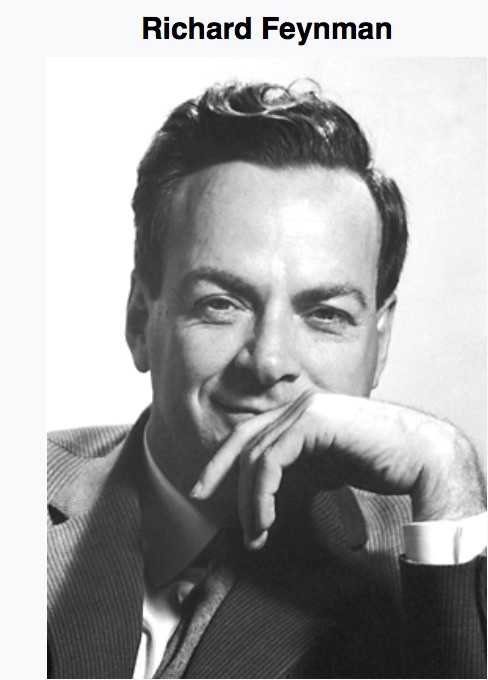
Richard Phillips Feynman was born on May 11, 1918 in New York City. He enrolled at the Far Rockaway High School, that was also the alma mater of fellow Nobel laureates Burton Richter and Baruch Samuel Blumberg.Upon starting high school, Richard was quickly promoted to a higher math class. An IQ test administered in high school estimated his IQ at 125, although if he had taken an IQ test as an adult, he probably would have scored much higher, since he later won Putnam Fellow status in the prestigious Putnam Examinations–a much greater challenge than an IQ test.
When Feynman was 15, he taught himself trigonometry, advanced algebra, infinite series, analytic geometry, and calculus. On graduation, he attended MIT majoring in mathematics, but later switched to electrical engineering, and then to physics. For his graduate work, he went to Princeton where he served as a research assistant to Professor John Wheeler. He and Wheeler had resolved some issues concerning the exchange of energy during the interaction of electrons, and Wheeler suggested that Feynman present their results in an upcoming seminar so that he could acquire some experience in giving presentations. The physicists invited to this seminar read like a Who’s Who? of the top theoretical physicists of the time. It included John von Neumann, Wolfgang Pauli, and Albert Einstein who was at the Institute for Advanced Study in Princeton. In his autobiographical book, Surely You’re Joking, Mr. Feynman! written 40 years later, Feynman recalled his first and only dramatic encounter with Albert Einstein: (pp. 65-66)
[Before my lecture was about to begin] I was writing these equations all over the backboard ahead oftime, Einstein came in and said pleasantly, “Hello, I’m coming to your seminar. But first, where is the tea?” I told him, and continued writing the equations.
Then the time came to give the talk, and here are these ‘monster minds’ in front of me, waiting! My first technical talk–and I have this audience! I mean they would put me through the wringer! I remember very clearly seeing my hands shaking as they were pulling out my notes from a brown envelop.
But then a miracle occurred, as it has occurred again and again in my life, and it’s very lucky for me: the moment I start to think about the physics, and have to concentrate on what I’m explaining, nothing else occupies my mind–I’m completely immune to being nervous. …
But then the end of the seminar came, and it was time for questions. First off, Pauli, who was sitting next to Einstein, gets up and says, “I do not sink dis teory can be right, because of dis, and dis, and dis,” and he turns to Einstein and says, “Don’t you agree, Professor Einstein?”
Einstein says, “Nooooooooooooo,” a nice, German-sounding “No”–very polite. “I find only that it would be very difficult to make a corresponding theory for gravitational interaction” He meant for the general theory of relativity which was his baby… Einstein appreciated that things might be different from what his theory stated: he was very tolerant of other ideas.
Einstein and Feynman never met again because Einstein was in the sunset of his career and Feynman was in his early years of exploration. This Einstein-Feynman encounter, in which the old authorities pass the torch to the next generation, is captured in Max Planck’s observation, “Science advances one funeral at a time.”
At age 25, Richard Feynman delivered a lecture on Some Interesting Properties of Numbers to the world’s most distinguished physicists, who were gathered together in Los Alamos to develop an atomic bomb. Among the ideas he discussed was Euler’s remarkable formula, eiπ + 1 = 0 which he used to dazzle the physicists who were unaware of the “magic” of this equation.
Feynman developed a widely used pictorial representation scheme for the mathematical expressions describing the behavior of subatomic particles, which later became known as Feynman diagrams. He is also known for his work in the path integral formulation of quantum mechanics, the theory of quantum electrodynamics, and the physics of the superfluidity of supercooled liquid helium. In 1965 he received jointly with Julian Schwinger and Shin’ichirō Tomonaga the Nobel Prize in Physics.
Later, reflecting on the aesthetics of mathematics, he wrote: To those who do not know mathematics, it is difficult to get across a real feeling as to the beauty, the deepest beauty of nature. … If you want to learn about nature, to appreciate nature, it is necessary to understand the language that she speaks in.
